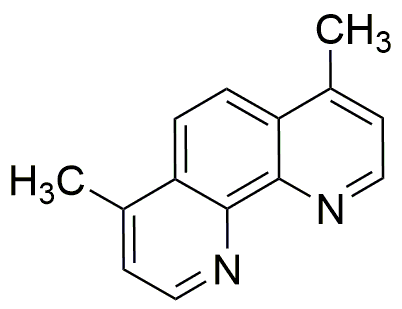4,7-Dimethyl-1,10-phenanthroline is widely utilized in research focused on:
- Coordination Chemistry: This compound serves as a bidentate ligand in coordination complexes, enhancing the stability and reactivity of metal ions, which is crucial for various chemical syntheses.
- Analytical Chemistry: It is employed in spectrophotometric methods for detecting and quantifying metal ions, offering high sensitivity and selectivity, making it ideal for environmental and industrial monitoring.
- Biochemical Research: The compound is used in studies involving DNA and RNA interactions, aiding in the development of new therapeutic agents and understanding genetic mechanisms.
- Material Science: It contributes to the development of luminescent materials and sensors, which are valuable in electronics and photonics industries due to their unique optical properties.
- Catalysis: This chemical is utilized in catalytic processes, enhancing reaction rates and selectivity in organic synthesis, providing a more efficient alternative to traditional catalysts.
General Information
Properties
Safety and Regulations
Applications
4,7-Dimethyl-1,10-phenanthroline is widely utilized in research focused on:
- Coordination Chemistry: This compound serves as a bidentate ligand in coordination complexes, enhancing the stability and reactivity of metal ions, which is crucial for various chemical syntheses.
- Analytical Chemistry: It is employed in spectrophotometric methods for detecting and quantifying metal ions, offering high sensitivity and selectivity, making it ideal for environmental and industrial monitoring.
- Biochemical Research: The compound is used in studies involving DNA and RNA interactions, aiding in the development of new therapeutic agents and understanding genetic mechanisms.
- Material Science: It contributes to the development of luminescent materials and sensors, which are valuable in electronics and photonics industries due to their unique optical properties.
- Catalysis: This chemical is utilized in catalytic processes, enhancing reaction rates and selectivity in organic synthesis, providing a more efficient alternative to traditional catalysts.
Documents
Safety Data Sheets (SDS)
The SDS provides comprehensive safety information on handling, storage, and disposal of the product.
Product Specification (PS)
The PS provides a comprehensive breakdown of the product’s properties, including chemical composition, physical state, purity, and storage requirements. It also details acceptable quality ranges and the product's intended applications.
Certificates of Analysis (COA)
Search for Certificates of Analysis (COA) by entering the products Lot Number. Lot and Batch Numbers can be found on a product’s label following the words ‘Lot’ or ‘Batch’.
*Catalog Number
*Lot Number
Certificates Of Origin (COO)
This COO confirms the country where the product was manufactured, and also details the materials and components used in it and whether it is derived from natural, synthetic, or other specific sources. This certificate may be required for customs, trade, and regulatory compliance.
*Catalog Number
*Lot Number
Safety Data Sheets (SDS)
The SDS provides comprehensive safety information on handling, storage, and disposal of the product.
DownloadProduct Specification (PS)
The PS provides a comprehensive breakdown of the product’s properties, including chemical composition, physical state, purity, and storage requirements. It also details acceptable quality ranges and the product's intended applications.
DownloadCertificates of Analysis (COA)
Search for Certificates of Analysis (COA) by entering the products Lot Number. Lot and Batch Numbers can be found on a product’s label following the words ‘Lot’ or ‘Batch’.
*Catalog Number
*Lot Number
Certificates Of Origin (COO)
This COO confirms the country where the product was manufactured, and also details the materials and components used in it and whether it is derived from natural, synthetic, or other specific sources. This certificate may be required for customs, trade, and regulatory compliance.


